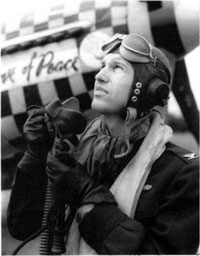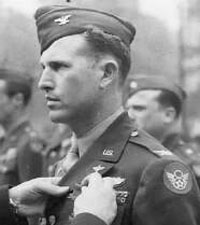| |
| |
|
Col. Glenn E.
Duncan Pilot Ace 353rd FG C.O. |
|
by AcePilots.com |
|
|
|
Dove of Peace VII headed
for the deck and opened up with all eight fifties, strafing the He-111
bombers on the field at Wesendorf in western Germany. It was one month after
D-Day, July 7, 1944, and Col. Glenn Duncan was leading his Group, the 353rd,
on a diversion from the bombers. As he roared over the airfield, German flak
gunners aimed their deadly 88mm anti-aircraft guns at his P-47 Thunderbolt.
They found the range and hit his plane in an oil line, a certainly crippling
wound to the big fighter, as its Pratt & Whitney radial would soon overheat.
Duncan knew that he wouldn't get far, but fought for altitude, so that he
could get as far West as possible, hopefully out of Germany. He didn't make
it. Other pilots of the Group followed him and saw him belly in near
Nienburg. As he walked away from the plane, he tossed an incendiary grenade
into it, denying the Germans their prize. He kept walking towards Holland.
Glenn Duncan, born in 1918,
was one of relatively few experienced Army pilots who joined the 353rd
Fighter Group when it was formed in late 1942. Equipped |
| |
 |
| |
Col Glen Duncan & Dove
of Peace |
|
|
with Thunderbolts, they
followed the 56th and 78th Groups to Europe, arriving in the UK in June
1943. At this point, Duncan was the Group Exec. He flew a few missions with
the 78th that summer.
On September 23, 1943, he scored his first victory, an FW-190 over Nantes.
Flying frequent escort missions, he claimed two German fighters on Nov. 11,
and became an ace, with his fifth victory, on Dec. 20. He made full Colonel
in November, and took over command of the 353rd.
One day in early 1944 - He was leading the Group, escorting heavy bombers
near Ans, Germany. He flew with the lead squadron at 22,000 ft.; the second
flew high cover at 33,000; and the third was at 25,000 as a bouncing
squadron. At 1215 recall was given and he began to descend, heading below
some cirrus clouds. Twenty minutes later, the lead squadron was at 15,000
ft. |
 |
|
|
Col Glenn Duncan receiving |
|
|
the French
Croix de Guerre |
|
|
A milk run mission was
almost over when he saw airplanes off to his left and low, twin-engined ME
110s. By this time he was down under some scattered cumulus at about 7,000
ft.. He saw four ME 110s flying a swept-back line-abreast formation, at
about 5,000 ft. He pulled the throttle, turbo, and prop levers all the way
back, to slow down, but was still closing too fast. He made a sharp left
return then swung around so as to come in behind the last ME 110. Still he
was closing too fast. Then he threw in a few skids and at the last moment
before overshooting, he barrel-rolled and came in position on the Hun's
tail. He closed up to about 250 yards, cantered the needle and ball, put the
pipper on the top of the cockpit, then squeezed in a long burst. The ME 110
immediately began losing pieces and flamed up. He must have killed the rear
gunner in the first few rounds because he was not shooting. This ME 110
veered off to the left and down, then crashed.
During this time the other ME 110s (three black and one white) had made a
sweeping turn to the right and were now in line astern formation.
|
|
He pulled over the ME 110
that he had just shot down and came in behind another. This rear gunner was
really excited and shooting like mad. They must have been very poor gunners
because Duncan held his fire until he pulled up to about 250 or 300 yards
then gave him a good long squeeze. (He found later that he had picked up one
.303 slug in the right side of his engine from this gunner.) The Me-110
immediately burst into flames and pieces flew everywhere.
By June 7, 1944, he had accumulated 15.5 kills; on the 12th, he knocked down
three Bf-109's. He claimed his last on July 5, and two days later flew the
ill-fated mission described in the opening paragraphs. After being shot
down, he did evade the Germans, and hooked up with the Dutch Resistance.
When the Americans liberated Holland in April, 1945, he rejoined his Group.
He stayed in the Air Force after the war, among other assignments serving as
White House liaison, NORAD, and with air divisions in Korea and Japan. He
retired as a Colonel. His decorations include a DSC, Silver Star, DFC with 7
OLC's, Air Medal with 3 OLC's, the French Croix de Guerre, and the British
DFC |
| |
Acknowledgements:
My thanks to
http://www.acepilots.com for their permission to use the article on Col
Glenn E. Duncan, DSC, DFC. |
|
|
|


